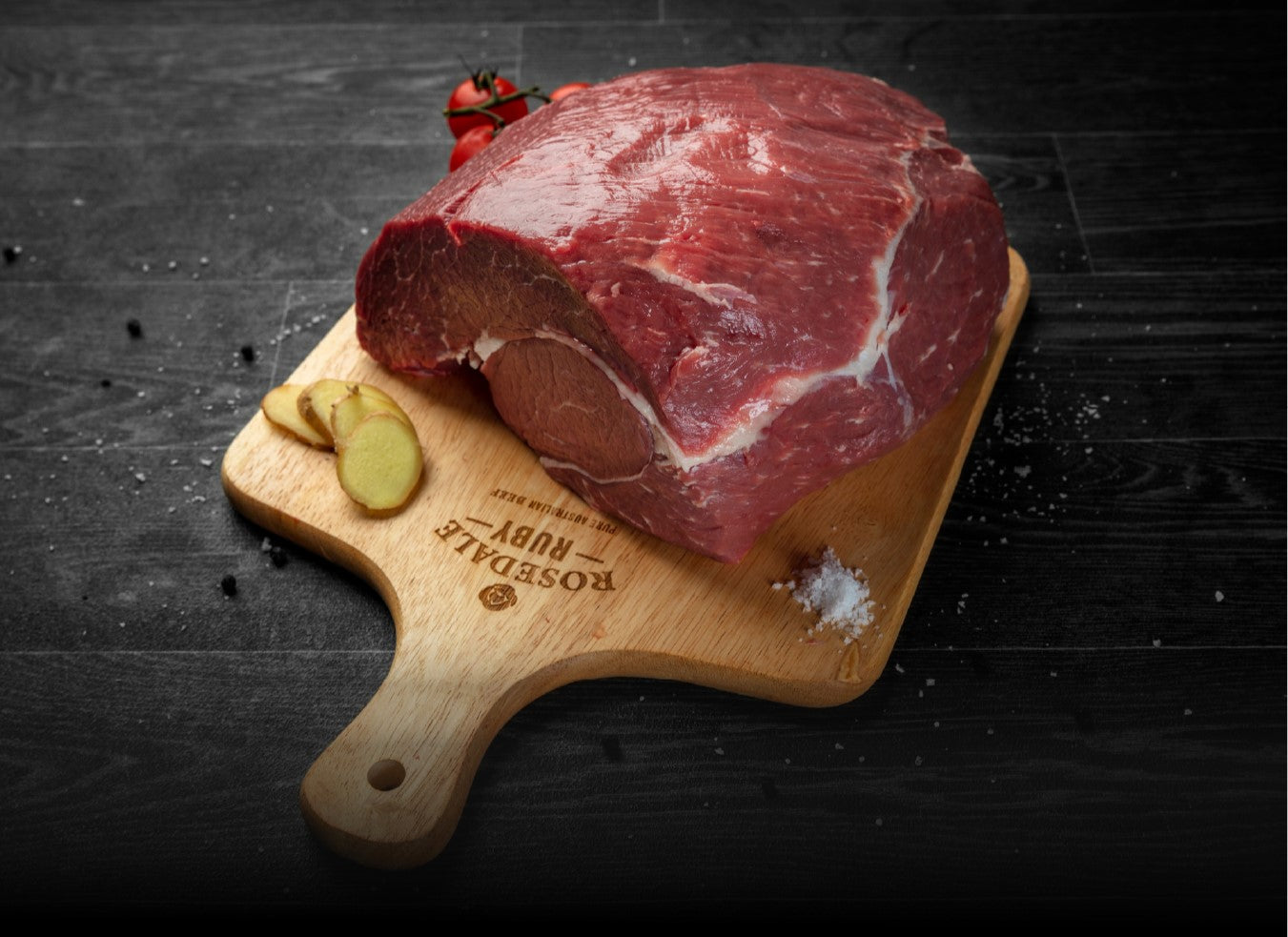فهم القطع المختلفة من الستيك
اختيار النوع المناسب من الستيك يمكن أن يصنع فرقًا كبيرًا في جودة وجبتك. تختلف نسبة الدهون، ودرجة الطراوة، وطريقة الطهي لكل قطعة، مما يؤثر على النكهة والقوام. سواء كنت تشوي، أو تقلي، أو تحضّر أطباق خاصة كالفوندو أو الكارباتشيو، فإن اختيار القطعة الصحيحة يضمن تجربة طعام ممتعة. في هذا الدليل، سنستعرض أشهر القطع ونوضح التصنيفات والمصطلحات الخاصة بالستيك، لمساعدتك في تحديد الخيار الأفضل لاحتياجاتك.
أشهر قطع الستيك وخصائصها
كل قطعة من الستيك تتميز بنكهة مختلفة ونسبة دهون وطريقة طهي مثالية. إليك دليلًا سريعًا لأشهر القطع:
-
ستيك T-bone:
يجمع بين التندرلوين وشرائح الستريب، يفصل بينهما عظمة على شكل حرف T. يتميز بنكهات غنية ويُفضل شويه للحصول على مزيج من الطراوة والطعم الغني. -
ستيك السيرلوين:
قطعة متوسطة الدهون مأخوذة من الجزء الخلفي للبقرة. مناسبة للشوي أو الطهي السريع في المقلاة، وتحتفظ بعصارتها دون أن تكون دهنية جدًا، مما يجعلها خيارًا متعدد الاستخدامات. -
ستيك الرامب:
يتميز بقوامه المتماسك ونكهته القوية، ويُفضل طهيه على نار هادئة بالشواء أو التحميص لتطرية الألياف. -
ستيك الفيليه:
أطرى قطع الستيك وأقلها دهونًا، مأخوذ من الجزء الصغير من التندرلوين. يُفضل طهيه سريعًا على حرارة عالية للحفاظ على قوامه الرقيق، ويُعتبر خيارًا فاخرًا في الأطباق الراقية. -
ستيك الريب آي:
يُعرف بتشريحه الغني بالدهون ونكهته القوية، ويأتي من الجزء العلوي للأضلاع. الدهون تذوب أثناء الطهي، مما يجعله مثاليًا للشواء أو القلي لإعطاء قشرة مقرمشة وقلب عصاري. -
ستيك الفلانك:
قطعة طويلة وخالية من الدهون تُؤخذ من عضلات البطن. تُعرف بنكهتها العميقة وقوامها المتماسك. تُطهى عادةً على حرارة عالية بعد تتبيلها، ويتم تقطيعها رفيعًا عكس اتجاه الألياف لتحسين طراوتها. -
البريسكيت:
قطعة صلبة مأخوذة من الصدر السفلي، تُستخدم في طرق الطهي البطيء مثل الطهي على البخار أو التدخين. الوقت الطويل للطهي يساعد على تفكيك الأنسجة، مما يجعلها مفضلة للشواء أو الطهي التقليدي. -
ستيك الفلات آيرون:
قطعة مأخوذة من الكتف، طرية ولكن بها نسبة دهون جيدة. مثالية للشوي أو التحميص، وتُعتبر خيارًا اقتصاديًا ولكن مليئًا بالنكهة. -
ستيك التوماهوك:
عبارة عن ريب آي مع ترك العظمة الطويلة سليمة، مما يضيف مظهرًا مميزًا ونكهة إضافية أثناء الطهي. غالبًا ما يُشوى أو يُحمّر ويُناسب عشاق النكهات القوية.
الفرق بين القطع الطرية والصلبة
ترتبط طراوة الستيك ببنية العضلات في القطعة. القطع الطرية تأتي من الأجزاء الأقل حركة في جسم البقرة مثل الفيليه والريب آي. أما القطع الأكثر صلابة مثل الفلانك والبريسكيت فتأتي من العضلات النشطة.
تحتاج القطع الصلبة إلى طرق طهي بطيئة مثل الطهي على نار هادئة أو الشواء الطويل لتطرية الأنسجة. بينما يمكن طهي القطع الطرية بسرعة على حرارة عالية، مثل شوي الفيليه أو قليه على المقلاة.
دور الدهون في النكهة والطهي
الدهون تلعب دورًا كبيرًا في نكهة الستيك وقوامه. القطع التي تحتوي على دهون أكثر، مثل الريب آي، تُعرف بتشريحها الرخامي حيث تذوب الدهون أثناء الطهي مما يُعزز النكهة. أما القطع الأقل دهونًا مثل الفيليه فتتميز بنكهة خفيفة تناسب من يفضلون مذاقًا أقل دسامة.
التشريح الرخامي (Marbling) يشير إلى خطوط الدهون الرفيعة داخل العضلة، وهو مؤشر رئيسي لجودة الستيك. على سبيل المثال، يتميز لحم الواغيو بتشريح رخامي كثيف يمنحه قوامًا زبدانيًا، بينما يُقدم السيرلوين نكهة لحمية أكثر وضوحًا.
تصنيفات اللحوم ودلالتها
عند شراء الستيك، من المهم فهم أنظمة التصنيف لتحديد الجودة. في الإمارات، تعتمد اللحوم غالبًا على معايير دولية. على سبيل المثال، تُستخدم معايير اللحوم الأسترالية التي تُقيّم جودة التشريح الرخامي.
أما التصنيفات الأمريكية (USDA) فتقسم اللحوم إلى Prime, Choice, Select، حيث تُعد Prime الأعلى جودة لاحتوائها على تشريح رخامي وفير. فهم هذه التصنيفات يساعدك في اختيار القطعة الأنسب لاحتياجاتك.
اختيار القطعة المناسبة لطريقتك في الطهي
لكل قطعة طريقتها المثلى في الطهي:
- الريب آي والتوماهوك: يُفضل شويها أو تحميرها على نار عالية لإذابة الدهون وإضافة نكهة غنية.
- السيرلوين والفلانك: يُطهى بسرعة، سواء بالشواء أو القلي، مع تتبيل بسيط لتحسين الطعم.
- البريسكيت: مناسب للطهي الطويل بالبخار أو التدخين، مما يساعد على تطرية الأنسجة وإبراز النكهة.
المصطلحات المهمة في طهي الستيك
- الأنسجة (Grain): اتجاه الألياف العضلية في الستيك، وتقطيعها عكس الأنسجة يجعلها أكثر طراوة.
- التسوية (Resting): ترك الستيك ليبرد قليلًا بعد الطهي لإعادة توزيع العصارة.
- التشويح (Searing): طهي الستيك على حرارة عالية لتكوين قشرة لذيذة.
الاختيار الأمثل لوجبتك
الاختيار بين القطع يعتمد على المناسبة وطريقة الطهي. للوجبات الفاخرة، اختر الفيليه واطهه بشكل بسيط لإبراز قوامه. أما إذا كنت تبحث عن نكهة قوية، فالريب آي أو التوماهوك خيار مثالي. للوجبات المطهية ببطء، استخدم قطعًا مثل البريسكيت أو الفلانك للحصول على نكهة غنية.
اكتشف تشكيلتنا الفاخرة من اللحوم في مسقط للمواشي لتجد القطعة المثالية لوجبتك القادمة

